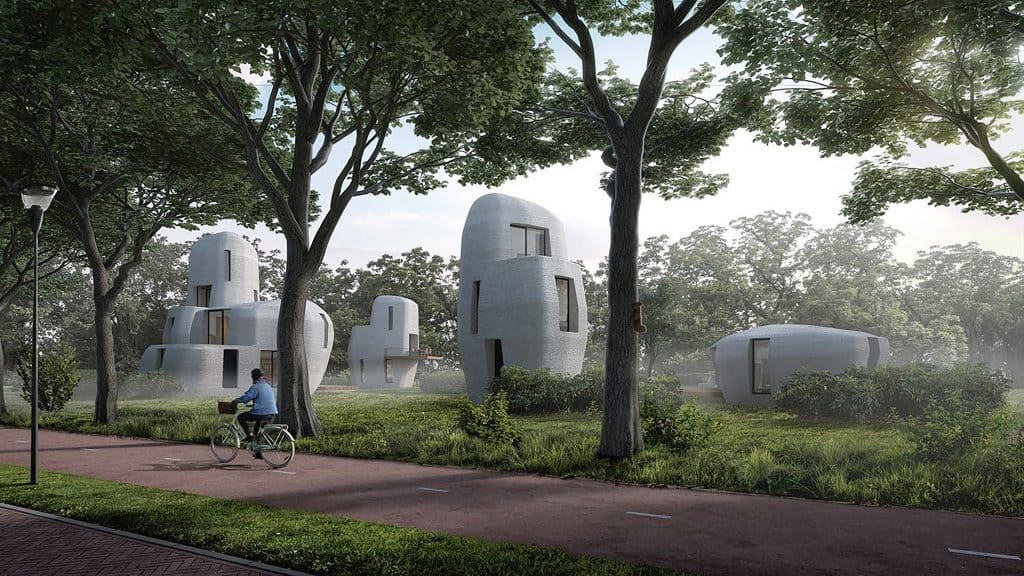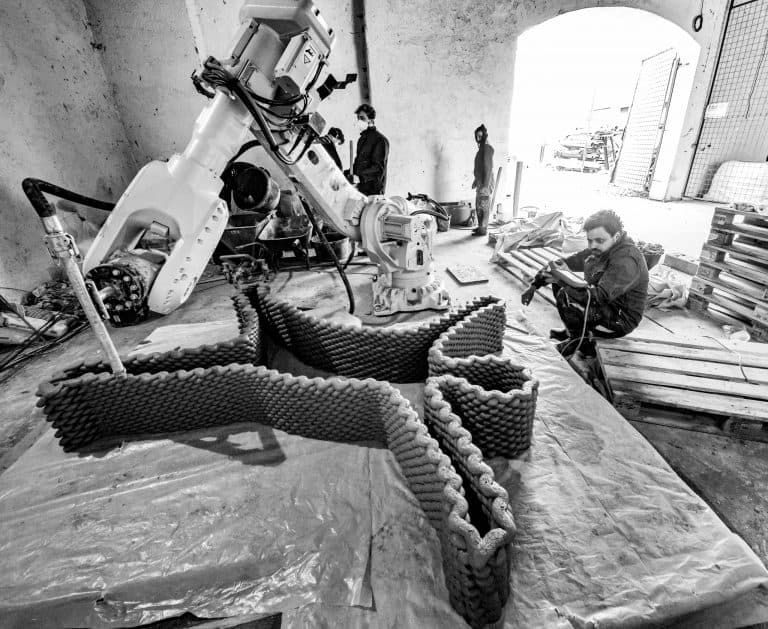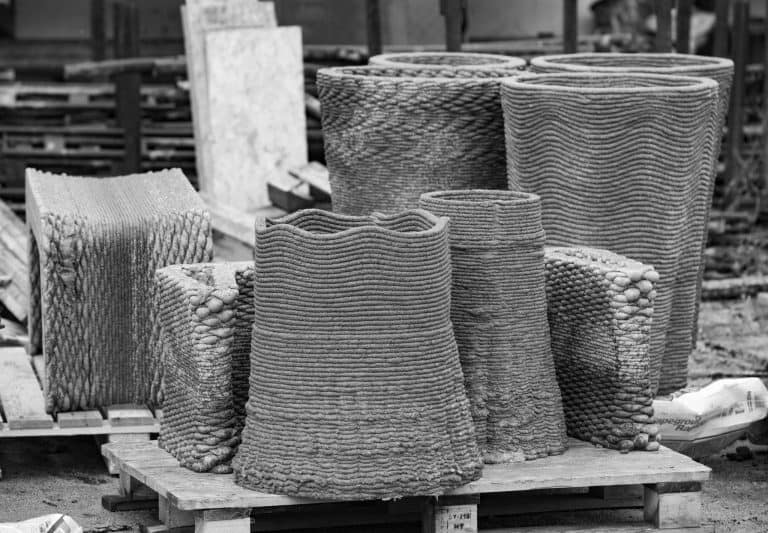3D-printed concrete: still in its infancy

Additive manufacturing, more popularly known as 3D printing, as a technology has been around since the 1980s. With 3D printing machines already available for home use, it’s small wonder then that companies have started looking into using 3D printing in construction. 3D printed structures – or at least the idea of it – has been a hot topic in the construction sector. It seems like almost weekly, there is news of new plans to 3D print structures ranging from bridges to houses that developers say can be built in a day. After the initial media excitement, though, news of the success of these projects seem to be slow in coming, if at all. To shed light on this topic, we asked several experts for their take on the state of 3D printing in construction today.
One approach to automatization
There’s a lot of hype surrounding 3D printing in construction. On a big scale, 3D printing in construction is still in the very early stage of development. Concrete is a very challenging material for 3D printing. A construction 3D printer works by depositing materials such as concrete, layer by layer, through a nozzle. Therefore, while printing, concrete must be fluid so it can flow out of the nozzle. After printing, concrete must lose a major part of its fluidity quickly to keep the printed shape. However, concrete should not stiffen too fast to give layers time to adhere to one another. If the layers are just sitting on top of other layers without any strong connection between them, it will result in weak structure without any tensile strength. This all means we cannot use normal concrete in 3D printing, a special type of concrete – always with different kind of admixtures – will always be needed.
We also have to take into account the complexity of the structures we are building. 3D printing would be best suited for simple structures. For instance, wall structures in Northern Europe are rather complex and the use of 3D printing in those structures is rather challenging. The sandwich-wall structure is already challenging for 3D printing: You have three layers in the structure – the inner wall, a layer of insulation and an outer wall. In addition, you normally have different electrical wiring components assembled inside the wall structure. Printing a three-layer structure and assembling electrical components during the printing process is not an easy task. The whole wall structure needs to be redesigned for 3D printing.
The current speed of 3D printers is not comparable with modern precast factories. Also the quality of precasting is much better than in 3D printing. 3D printing allows manufacturing of complex shapes, but in case of typical concrete structures, such as walls, the efficiency of 3D printing is far from the efficiency achieved by of current precast technology.
In spite of its present limitations, we need be open to the possibilities that 3D printing brings. 3D printing can be seen as one approach to increasing automatization of construction. If we look at it objectively, 3D printing in construction is not very self-evident. More and more automatization will be needed in construction. 3D printing can be one tool to help develop automatization in construction, but certainly not the only tool.
We have to keep in mind that one major advantage of concrete is that it is a material you can cast into different forms, shapes and complexity. Different treatments for concrete surface are also now available. Concrete construction is basically based on this flexibility of cast concrete. With 3D printing we will change this totally. 3D printing certainly gives us new possibilities, but we also lose some advantages of using concrete.
Jouni Punkki
Professor of Practice (Concrete Technology)
Aalto University

Jouni Punkki
Professor of Practice (Concrete Technology)
Aalto University
Financial viability a big question in 3D-printed construction
We should look at 3D printing in construction as a very interesting technology that has some potential in the future. From the safety perspective, there are regulations that govern construction of any kind and there are, of course, requirements to add reinforced bars for support in 3D structures. Because the technology is so new and regulatory practices are ever changing, meeting these regulations might be a challenge for an emerging technology like 3D printing. But I don’t think concerns about 3D printed structures center around safety.
3D printing concrete faces the same issues that other industries using the technology are facing. Using molds to make parts through casting is going to be way faster. With 3D printing, you always have to wait to make sure that the previous layer can support the structure before adding the next layer.
One advantage that 3D printed structures can offer over conventional construction is how easier it would be to incorporate smart technology such as sensors, for example, which makes them easier to integrate into the smart city template. It’s much harder to retrofit existing houses made through traditional construction techniques, from that perspective.
Developing new technologies take time. It’s a question of trying and figuring out details and trying to make all the different variables work. 3D printing of concrete structures is something that will probably become more widespread. What shape it takes in the building industry is something we can’t predict at the moment.
The big question, of course, is can you make it financially viable? Is the technology something that customers would be interested in paying a premium for 3D printed houses, for example, instead of one built using other methods? Will the cost of acquiring be competitive or even comparable to what’s on offer in the market? There are other ways to achieve similar results and these options are less expensive and more readily available to the construction industry.
Jouni Partanen
Department head (Advanced Production Method)
Department of Mechanical Engineering
Aalto University


Many claims but not a lot of proof yet
There are a couple of companies in the US and in Europe who say they are concrete 3D printing companies, but in the past two or three years, they have only made quite small structures such as a family home. One Russian company has made a three-storey building in Dubai. There’s also this company in Estonia that’s about to build a 3D-printed house. We’ve been helping them to make it into a reality, but the finished product is yet to be seen.
Construction is a highly regulated industry and one reason stopping 3D printed concrete from becoming commercially available is because of all the regulations and the time it takes to get permissions. The concrete used for 3D printing is also more expensive than traditional concrete materials because of the admixtures needed to make sure it’s the right consistency.
The technology is continuing to develop though. When they 3D print a wall, they make it like a sandwich with two sublayers so there is space for pipes and ventilation, among others. In Zurich, they were able to construct a three-storey house using different technologies. They invented something called the “Smart slab” that had all the heating elements inside the slab, but they used very expensive 3D-printed moulds to achieve that. It was an experimental project to prove that the concept could work.
Most of the companies involved in 3D printing in construction of course say that it’s a better technology than precast, but so far, they haven’t really shown proof of that yet.
Ashish Mohite
Doctoral Candidate
Department of Mechanical Engineering
Aalto University

Ashish Mohite
Doctoral Candidate
Department of Mechanical Engineering
Aalto University
3D printing: promising but still a long way to go
The current technology used in construction is pouring concrete. To make this financially viable, you have to make the structures simple and standardised. If you don’t the cost goes up since you have to make and customize different moulds. The problem is that not only does this create elements that are not visually appealing, simple structures use a lot of concrete. With 3D printing, we can cut down about 50 percent of the concrete used by focusing on where the wall, for example, bears the load. I can print rows to make a slab and only use materials in those places where I actually need it. However, this means we need to develop new design methodologies at the time as well to benefit from the new technology. Unfortunately this takes time.
The industry is focused on what material is currently available. I think if you’re going to change something, it’s a good idea to look at it from a societal and sustainability perspective. I saw an opportunity when working with digital concrete: everyone is supportive of changing the makeup of concrete because 3D printing is not perceived as a threat by the traditional construction industry.
I think there’s also a lot of possibility offered by 3D printing to make more smart materials. Why not bind electric conducting materials in the concrete so we don’t have to put wires in our concrete structures anymore? With 3D printing, you can add per centimetre, make changes in the material, make it bind electricity in the exact spot you want, make the concrete translucent where you want. It’s about combining 3D printed concrete with smart technology to benefit us as a society.
One stumbling block is economic viability. Technology like 3D printing will not be adopted widely if there’s no visible economic benefit at some point in time. So manufacturers could maybe look into expanding their business model so construction is not judged just on the price of the house or structure being built, but also on the impact it has on our ecosystem and its sustainability.
That being said, there is a lot of difference in 3D printing a bridge versus a house. We announced a project to build 3D printed houses in Eindhoven two and half years ago and the first house is still not built. The complexity becomes evident once compared to the first printed bridge. The first bridge opened within a half year after the start of the project.
We have learned that it is awfully difficult because when building a house, there are complicated systems – HVAC, electricity, internet connectivity – that you have to take into account. It took us a long time to figure out how to do that and I think it will take many more years before we can print houses or buildings on a larger scale. Bridges are more simple to 3D print, since they have less details.
Theo Salet
Dean of the Department of the Built Environment
Full Professor of Structural Design / Concrete Structures
University of Eindhoven

Theo Salet
Dean of the Department of the Built Environment
Full Professor of Structural Design / Concrete Structures
University of Eindhoven
Perfect for decorative elements but not yet for structural components
3D printing is a very interesting production system which we are following very closely. It’s already being used in many sectors, such as steel and plastic production and in aeronautics, particularly in the manufacture of airplane parts. However, it is not as widely used in the construction industry.
As experts have noted, there are still a lot of challenges that need to be resolved before 3D printing makes its mark on construction. I believe it is the future of our business – it’s just a question of how and when. Right now, 3D printing is mostly used to create decorative elements. In some cruise ships, 3D-printed elements made from plastic and cellulose fibers are used as part of the interior design.
Although concrete is not widely used for 3D printing yet, it provides a lot of benefits: it is fireproof, strong and could withstand the elements. This is what makes it the perfect material for 3D-printed external elements, such as statues or columns, especially since people are looking for something beyond the basic boxlike precast structures.
Decorative elements can, of course, be cast in concrete; but this requires form workers who are craftsmen. One practical application for 3D printing in construction is in the making of molds. In complicated precast projects, creating the mold is always a challenge as it requires a lot of labor and precision. If molds were 3D printed, the process becomes easier and requires less labor.
There have been tests carried out on 3D printing whole structures using concrete, such as single family dwellings. It’s good that these tests are being done, but it is also clear that 3D printed concrete still has a long way to go. There are quality and technical challenges that need to be overcome, especially when we start thinking about 3D printing big structures like multi-story buildings. Building with 3D printed concrete also faces an economic challenge. Additives needed to make concrete work with 3D printing technology are very expensive.
Construction that relies fully on 3D printed concrete – where all reinforcement, HVAC and sewage systems are integrated and not put in separately as they are done today – is just not possible at the moment. Maybe in the future, when we have developed concrete technology to the right level, 3D printing structures will be a viable option.
Petteri Laitinen
Vice President, Projects and Services
Elematic

Petteri Laitinen
Vice President, Projects and Services
Elematic